30 Years of Apprenticing with Local Masters
Posted on
04/24/23
Author
Simon Hart
This is for the weavers, jewelers, painters, ceramicists, wood carvers, drum makers, fishermen, farmers, herbalists, block printers, basketmakers, cooks, tailors, musicians, dancers and singers. This is an homage to the makers—makers of fabric, art, food, music and beauty who have, for nearly 30 years, made space in their daily lives to work with young Dragons students.
Some of my first memories were made under my mother’s loom, amidst the dust balls and thumping of the weft being pounded into the warp to make rugs, smocks and skirts for sale out of an old fishing shack down on the marina. Throughout my childhood, I continued to learn to swing a hammer, lay stone, carve wood and work with tools to make things. The older I got, the less I made, until, at some point in college, I was sick with abstraction and theory. I spent hours and hours deciphering text, writing essays and staring at a screen. As an adult, I endeavor to work with my hands as well as my brain—to make things rather than buy them, and share with my own children the joy of making things with our hands. Through it all, I’ve come to admire and, yes, even romanticize those individuals who are makers of things, who have become masters of their craft, and who can transform raw material into a practical useful tool or a provocative and beautiful piece of artwork.
In 2020, my 7 year old daughter Ruby and I walked into Pape Laye’s atelier de couture in Senegal. We were shopping for shirts at the well-known tailor who has fabricated hundreds of Dragons tote bags and student wardrobes. We were laughing and hanging out with Pape Laye’s wife and his baby in the front of the shop when Ruby disappeared. I walked through the curtains into the back room where rolls of wax print fabric and several lines of sewing machines lived. There, hunched over a sewing machine, was a seamstress out of place; a young Dragons student learning to make clothes for her Independent Study Project (ISP). As I witnessed her working through the stitches alongside another local seamstress, I couldn’t help but feel proud of what her program was accomplishing in that moment. This student, who had achieved the highest accolades of academia and likely had all the doors open to them to pursue whatever high powered career they may choose was now, in this moment, learning to work with her hands, to make clothing, to be a producer, and to understand how many hours of labor and skill go into making a shirt.
But it wasn’t just about the shirt. More important are the hours spent drinking tea and making small talk with Pape’s wife and infant child, or the jokes that passed between them in the process. Working with our hands gives a sense of accomplishment and a sense of connection. It makes us human.
As we come into 2023 to celebrate 30 years of Dragons programming, gratitude is at the forefront. When I saw that student sewing a shirt in the back of Pape’s shop, I thought of the thousands of Dragons of students who have also had the distinguished honor to work alongside masters of the craft. Masters such as Ni Shang Laoshi, who has worked with dozens of students in Kunming over the years. Thanks to Jesse Millet, we were able to catch up with Ni Shang recently to ask about her work with Dragons students (translation by Jesse Millet):
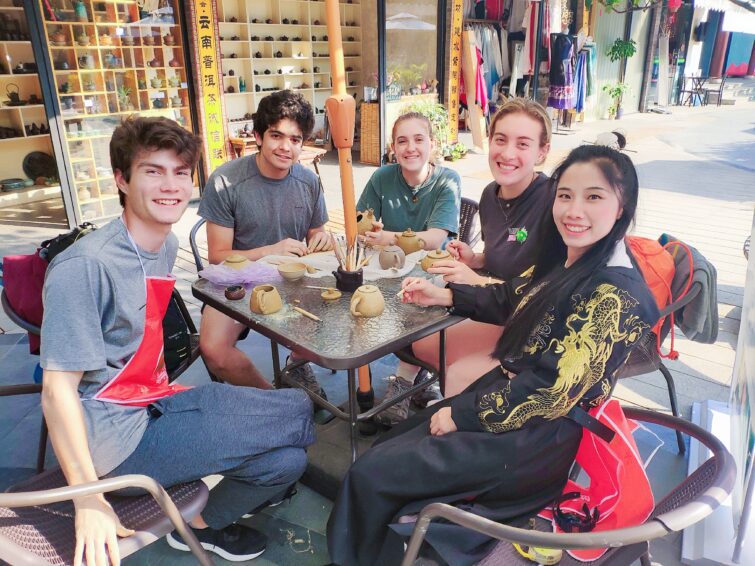
Ni Shang (pictured far right) works closely with students, teaching them how to make traditional Chinese pottery
NI SHANG – Ceramics
What is most meaningful to you about working with Dragons Students?
“Actually, I learned just as much from Dragons students as they did from me. Academically, they are more motivated than Chinese students. If they don’t understand something they will ask me, look it up, or find other ways to understand. 动手能力特别强,领悟力佳 They can fully achieve their academic goals. In life, they are fearless and easy-going. They have many life skills like good time management. This is something I learned from them. These students were really good at finding what they liked to do and eating what they wanted. 不会像我们很多人一样,碍于情面,去做很多讨好别人,让自己不开心的事情. They are very independent and are always interested in learning new things. I not only was their teacher but I also became friends with many of them. And throughout our interactions, I was able to get a glimpse of the world outside of China. I really like to have these types of culture exchanges so that we can learn about each other’s cultures and understand more diverse perspectives. When I was with these students I was very happy and gained a lot. I am very thankful to have had the opportunity to teach them and for every minute I spent with them.”
What is it about ceramics and working with your hands that you love most?
“I come from a very traditional family where most of my life my parents wanted to choose everything for me including what I studied, where I worked, and even who I married. But doing pottery was my own choice. I am passionate about Chinese culture and love traditional crafts. My favorite is ceramic arts. I like to see how a block of mud can shape into pottery. I love spinning the potter’s wheel and firing in the kiln. Making pottery can show you how you can shape a block of mud into anything you want and when firing you can witness the important process of turning mud into ceramics. 入窑一色,出窑万彩 (Enter the kiln as one color; and come out as ten thousand colors). This is a really uplifting feeling and can make you very happy. I also just love sharing what I know with others because it can double the happiness.
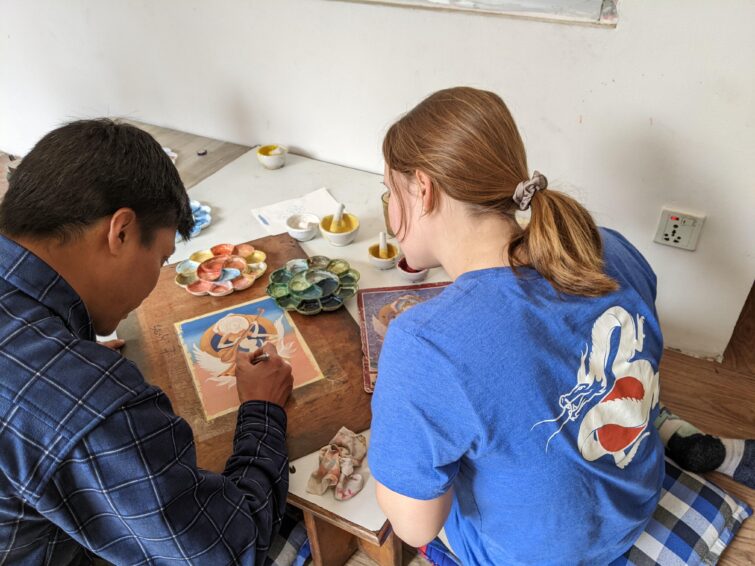
Saziv Shakya (left) works one on one with a Dragons student, teaching them how to paint in traditional and modern styles in Nepal
In Patan, an ancient city in the South Central Kathmandu Valley, and program base for Dragons Nepal programming, Nick Gredin helped us to sit down with Saziv Shakya, a Paubha painting mentor and exceptional painter who blends traditional and modern styles. Saziv is beloved in the Dragons community, and has worked with Dragons for over ten years. He teaches painting, but also the deep Buddhist philosophy and symbolism behind the practice. His brother is a Buddhist scholar and his family has hosted students many times in their home—something that “stirs the pot” in the group dynamics because of the jealousy involved when certain students have the honor to live or work with Saziv.
SAZIV SHAKYA – Painting
What do you most notice about working with Dragons students?
Dragons students are inquisitive and critical, often taking a scientific approach, and very interested to understand what we are teaching. They also desire to be creative. They are interested in learning new ways of doing things; some of them even come with their own background in art and are able to learn our way quickly.
Why is painting important to you? What do you love about it?
Paubha painting is an ancient art done as a form of meditation. It creates positive vibrations in the hearts of its practitioners. The paintings also teach those who view them – the traditional forms depicted represent deep Buddhist teachings and are still used as instructional tools as well as meditation aids. When we practice our art continuously by teaching, painting, etc, it gives us a more positive mindset. In my studio we are doing a unique form that blends the traditional art with modern forms by using 3D-style representations rather than the traditional flat 2D. It’s not about profit; if I am able to share this with others, that is enough for me.
Yogyakarta, Indonesia is often referred to as the cultural and artistic capital of Indonesia, so students who have the privilege to study there are often awash in the presence of master artists and craftspeople of myriad trades. In particular, the area is famous for its block printing, silversmithing, batik, gerabah (ceramics) and wayang (leather puppets) artists. But when we asked Indonesia Coordinator Lutfi Handayani, who would be a good ISP mentor to highlight, Bu Susi immediately rose to the top. Bu Susi has worked with Dragons since 2013, having first been introduced to the program through Indonesia programming architect and cornerstone instructor Rita Sri Suwantari.
“When working with students, Bu Susi not only teaches how to make Batik, but also talks with students a lot about her life and knowledge, and shares cultural knowledge and events” says Lutfi. “Outside batik class, she likes to invite students and instructors to weddings, traditional ceremonies and dance performances. She offers students traditional foods near her house in a small Warung, and sometimes will dress students in traditional batik clothing to take them to weddings.”
BU SUSI – Batik (hand printed textiles)
What do you notice about working with Dragons Students?
I love working with Dragons students because most Dragons students are quick learning students, students understand the process very well. They follow what I teach them and they can finish the assignment on time. Students are also very creative and they have so many ideas. They can develop my ideas so that the result is different in good terms. I give them a sample and they can develop the color and other things so that the result is better.
What led you to become a batik artist? What do you love about it?
Batik is very typical of Indonesian culture, especially Yogyakarta. I want to preserve the culture of Yogyakarta. I was born in the Kraton (Palace) area where everyone is doing Batik. I did not learn Batik from my parents but rather from my neighbors. I was curious about Batik and then learned from the neighbors. Batik is the thing that I have loved so much for more than 35 years. From love, it turned into a vocation. And now Batik can support my life and raise 3 children. Now, I really enjoy my life since all of my kids are adults and working in different places.
Finally, we took a moment to catch up with Luis Alvarado (Guicho) in Tiquipaya, Bolivia, where Dragons maintains a program base at an organic farm, Finca Polen. Tiquipaya is an agrarian community in a semi rural area outside of the larger city of Cochabamba. Many residents here are highly accomplished makers of one sort or another, and share their expertise with students readily, be it weaving, farming, herbal medicines or musical instruments. Luis introduced us to Don Alfredo Terceros, a master silversmith with decades of experience evolving his artform. Don Alfredo has worked with students, instructors and admin as mentees in his craft. Learning to work with silver in Bolivia carries particular historical and economic significance beyond the tactile and artistic dimensions. As Guicho shares in a history lesson with Dragons student groups, Bolivia, it can be argued, largely funded the modern economic paradigm we live in with its seemingly endless supply of silver brutally extracted and sent to Western Europe during the colonial era.
DON ALFREDO TERCEROS
How has your experience teaching Dragons students been?
All teaching is also enriching, even more so if it is with youth from another culture who value traditional and ancestral knowledge. I have realized that with the [Dragons] students, there are many questions that have allowed me to develop my own knowledge and experiences, and I do it with pleasure.
In the two hours we spend together, sometimes a little bit more, they demonstrate an avid desire to learn and accomplish a piece of work. One can note the satisfaction of the accomplishment.
How did you become a silversmith? What do you love about it?
I started at 14 or 15 years old when my mother married for the second time, after being widowed when I was five. That marriage was with an artist, a jeweler from whom I learned by being close to him. I also had two uncles who were jewelers. I fell in love with this beautiful artistic profession, and I’ve been doing it for 53 years now. I am 68 years old. I hope to continue for a few more years, sharing my knowledge with the youth.
What I love about this art is the power to put into practice my imagination in all of its forms through the application of different techniques. To personalize the jewelry such that it transmits something; a story, a meaning. I love to produce pre columbian pieces, colonial work, etc. as well as my own original designs, the vernacular.
In the summer of 2021, Dragons offered new programming in North America, and one of the sites chosen was my childhood home on the Western Shores of the Gitchigumi (Lake Superior). Students there engaged in ISPs in the community I grew up in, a community rich in artists and craftspeople. As a result, our instrctor team had the experience of calling in favors from fishermen, mushroom hunters, ceramicists, musicians and builders. Operating a Dragons program in my own community profoundly shifted my perspectives on reciprocity, on the immense value and generosity that our ISP mentors offer students, and on the very personal work our instructors do to leverage relationships that open doors for students.
One of the mentors was my own mother. Now in her 70s, I was moved to watch as she shared 40 years of experience with two eager teenage students. I’ll never know if the reciprocity involved in that brief exchange was balanced, equal or “worth it” for her. How do we measure such things? I do know that she came away from that experience with a good feeling in her heart, and a sense of connection that will hopefully span the gaps in age, identity, culture and geography that tend to separate us as a global community. My hope is that the power of that connection fostered through communal participation in working with out hand
My hope is that we as a community can reciprocate the immeasurable gifts that our ISP mentors provide us by honoring the human connections fostered through our work together—sewing, making ceramics, painting, batik, weaving, etc. In these simple, yet profound art forms, we can find meaning for our own lives, and deeper connection across the many differences that separate us.

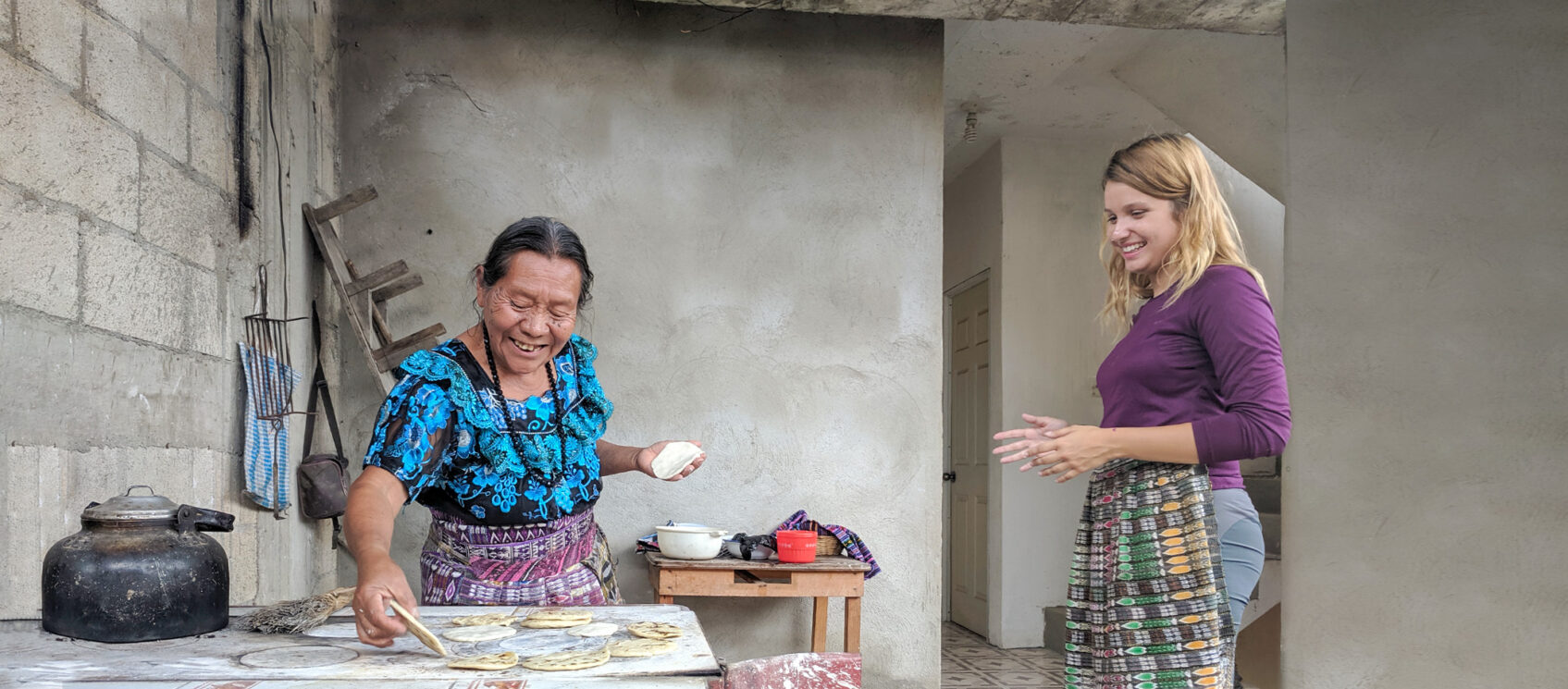
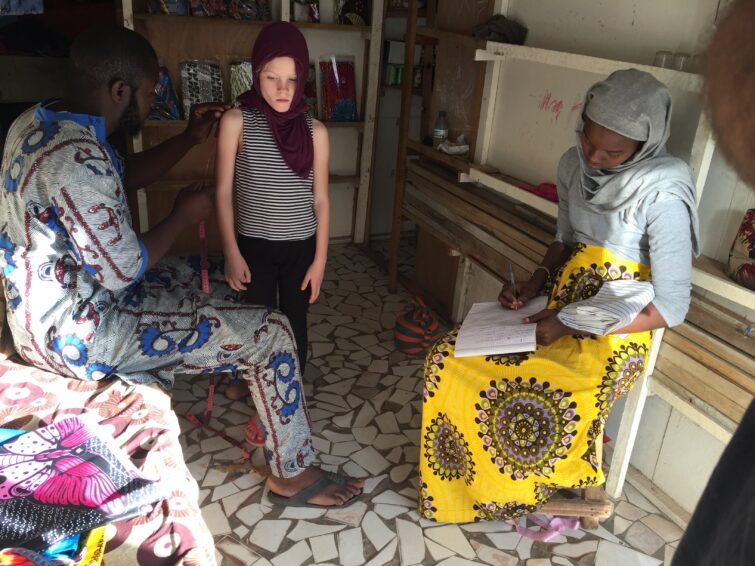
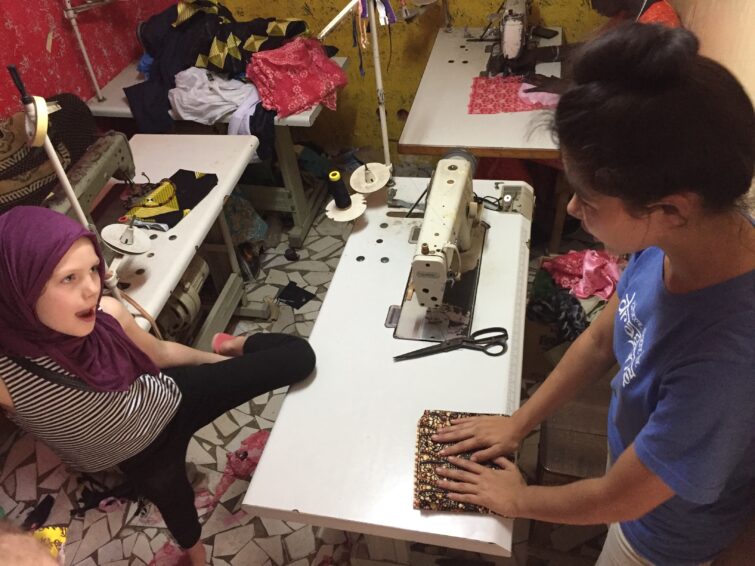
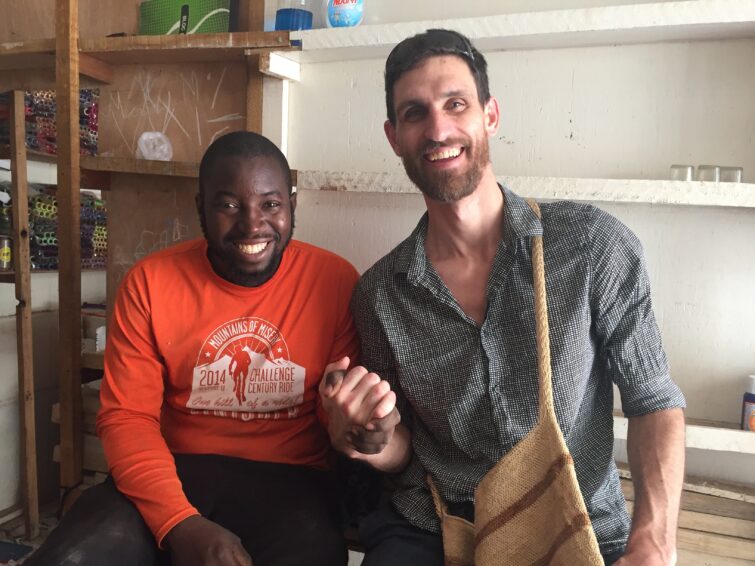
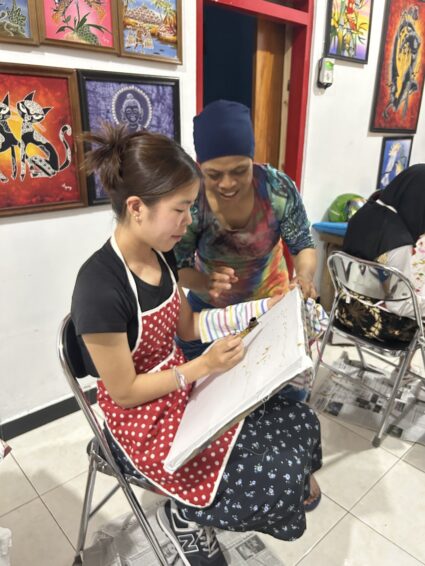
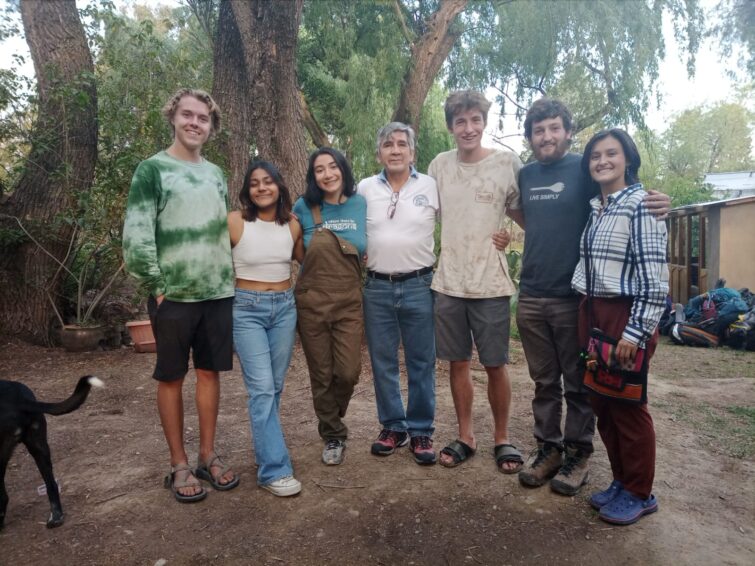
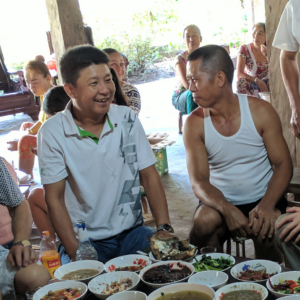
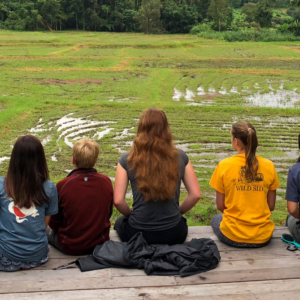

Leave a Comment